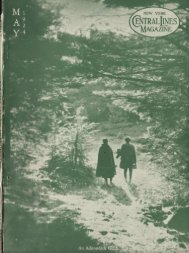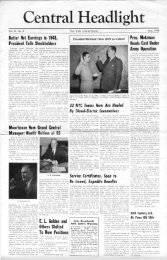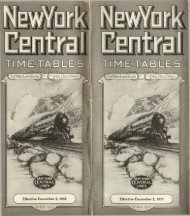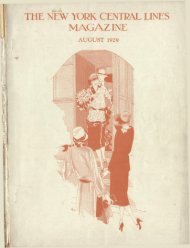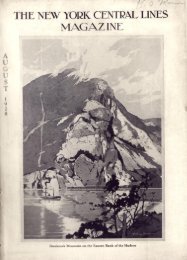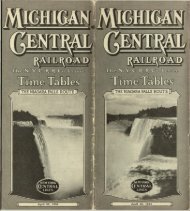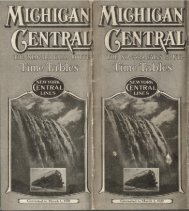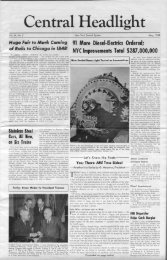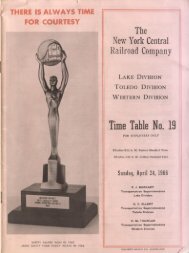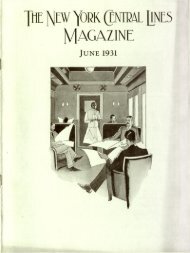Create successful ePaper yourself
Turn your PDF publications into a flip-book with our unique Google optimized e-Paper software.
T h e I m p o r t a nce o r A c c u r a t e v i s i o n i n<br />
P r e v e n t i o n o f Injury<br />
By Frank Mackin, Engineman, South em Division<br />
ACK of every accident there are<br />
B often many underlying factors<br />
not apparent at the time and place<br />
that have some bearing on the cause,<br />
and nowhere is this so true as in the<br />
matter of ability to see.<br />
Our sense of sight is the primary<br />
contributing agent for approximately<br />
70 per cent of our muscular activities.<br />
In many cases it is our response or<br />
failure to respond to visual impression<br />
that determines whether Safety<br />
or injury results. If indistinct vision<br />
causes a delay of even a fraction of<br />
a second in recognizing a point of<br />
danger, that delay may be just enough<br />
to tip the scales to the side of an unfortunate<br />
incident.<br />
Confidently, this is the explanation<br />
for many accidents where the injured<br />
person truthfully says he did not see<br />
the danger ahead. Beware of blindness<br />
due to the specular reflection—<br />
more commonly known as glare—from<br />
brightly polished material within the<br />
range of vision.<br />
The foreman in the shops should<br />
commence his daily work with the<br />
thought that he must, so far as it lies<br />
in his power, provide a safe place for<br />
his men to work. He should supervise<br />
his men by thoughtful consideration<br />
so that they will not be rushed in<br />
their work into becoming careless.<br />
Work can be performed expeditiously,<br />
and at the same time in a sane and<br />
safe way.<br />
Supervision is a leading element in<br />
accident prevention and the term implies<br />
more than a casual oversight of<br />
the men to be supervised. It means<br />
a human interest in their welfare. It<br />
is possible, in this consideration, to<br />
make the term so elastic as to include<br />
the engineman as supervisor of the<br />
fireman on his engine; or the conductor<br />
as the supervisor of his brakeman;<br />
the mechanic as supervisor of the<br />
helper who has been assigned to him.<br />
New York Central Lines Magazine for May, 1928<br />
Every foreman in every department<br />
should so undertake his duties as<br />
to have his men do their work in the<br />
safe way. Fewer errors and better<br />
quality work is a safe rule that brings<br />
rewards.<br />
Recklessness and What It Costs<br />
Employes<br />
TyRUISES, broken bones and other<br />
ID injuries, even deaths, are constantly<br />
occurring among railroad employes<br />
when a second's thought, a bit<br />
of care, would have kept the man<br />
alive and in sound condition many<br />
years longer. His life would have<br />
been happier, his family better cared<br />
for, if his recklessness had not deprived<br />
them of his capabilities.<br />
Examples of needless injuries to<br />
New York Central employes, all of<br />
them of recent occurrence, are given<br />
here:<br />
A brakeman's arm was amputated<br />
whin he fell and was run over while<br />
attempting to get on moving cars.<br />
Another brakeman had foot and<br />
ribs injured when he stumbled on<br />
running board and fell between moving<br />
cars.<br />
A baggageman, while crossing<br />
tracks ahead of passenger train, was<br />
struck by the train and killed.<br />
A ladder on a tugboat broke as the<br />
captain was descending it, and he was<br />
severely bruised by the fall.<br />
The hand of a car repairman was<br />
badly crushed while he was attempting<br />
to repair lock lifter on car. Other<br />
cars coupled on, catching his hand.<br />
An engineman was severely bruised<br />
about the head and back, when he<br />
fell from top of engine cab into a<br />
hopper car on an adjoining track.<br />
An electrician, while changing an<br />
electric light bulb, fell from the top<br />
of a twelve-foot ladder, breaking his<br />
collar bone.<br />
A bridge and building laborer was<br />
killed when he fell from top of engine<br />
house which his gang was preparing<br />
to dismantle.<br />
A car man off duty was crawling<br />
through ears on his way home from<br />
work. The train was moved and he<br />
fell and was run over. Result—three<br />
fingers of right hand amputated.<br />
While walking between two tractors,<br />
one of which was in gear, a<br />
crane operator caught his leg and<br />
fractured it as the switch was thrown.<br />
Stepping out of the way of a west<br />
bound train, a section laborer was<br />
struck by eastbound train and killed.<br />
Being struck and run over by engines<br />
or cars is still one of the outstanding<br />
causes of death to employes.<br />
A freight laborer's leg was badly<br />
strained when he stepped off the side<br />
of the bridge as he was trucking<br />
freight. His leg doubled up under<br />
him as he fell.<br />
Another freight laborer's foot was<br />
badly bruised while trucking freight<br />
with hand truck. He was struck by<br />
a tractor being operated by another<br />
employe.<br />
When two automobiles collided on<br />
a crossing, one struck the crossing<br />
watchman and fractured his ankle.<br />
New York Central Lines Magazine for May, 1928<br />
ricultun<br />
^f^olations<br />
Special Train Through Ohio and<br />
Stimulates Sugar Beet Imdust<br />
By E.J. LeenhoutS, General Agricultural Agent, Lines West<br />
Part of the 250 sugar beet growers who gathered to witness the sugar beet demonstration of the New York Central Lines<br />
Agricultural Relations Department when the special train stopped at Charlotte, Mich.<br />
"HAT'S the matter with<br />
the sugar beet business?<br />
" W e all right—if you use<br />
horse sense."<br />
This was the chorus of two songs,<br />
different in words, but identical in<br />
tune, which were sung this spring on<br />
board two New York Central Lines'<br />
Sugar Beet Demonstration Trains,<br />
one in Ohio and the other in Michigan.<br />
While the Ohio folks were chanting—•<br />
"A Beet Where a Beet Ought to Be,"<br />
the Michigan folks were humming<br />
"More Tons per Acre Make Greater<br />
Profits," and everyone, including the<br />
New York Central Lines, joined in<br />
the mighty chorus quoted above.<br />
The subject and tune of the song,<br />
coupled with the immediate response<br />
following its singing, leads us to predict<br />
that it will have a greater sweetening<br />
effect than any song ever sung.<br />
At any rate, after two years of<br />
planning and consultations, and several<br />
weeks of intensive preparation,<br />
on February 6 the Ohio Sugar Beet<br />
Demonstration Train started from<br />
Toledo for Findlay to carry the message<br />
of better beet culture into twenty-six<br />
localities on our lines in Northern<br />
Ohio. This train, in charge of<br />
Earle G. Reed, Agricultural Agent,<br />
New York Central Lines West, carried<br />
with it as the main speaker one of the<br />
country's foremost authorities on<br />
sugar beets, Dr. J. A. Brock, Agriculturist,<br />
of the Continental Sugar Company,<br />
Toledo. Included in this threecar<br />
train was a lecture car and another<br />
car fitted up with a series of<br />
exhibits, prepared by the Continental<br />
Sugar Company, pointing out distinctly<br />
and forcefully the steps which lead<br />
to profits in the sugar beet business.<br />
The expense of these exhibits was<br />
borne jointly by the Continental, the<br />
Toledo, the Columbia and the Ohio<br />
Sugar Companies. Officials from<br />
these various companies were on the<br />
train from time to time to assist in<br />
the program and also did much to<br />
create interest in the train through<br />
advance work and publicity.<br />
The twenty-six meetings and thirtythree<br />
lectures were attended by 2,346<br />
people, or better than ninety people to<br />
each stop. Since the lectures and exhibits<br />
were designed to appeal to<br />
sugar beet growers only, of whom<br />
there are relatively few to each locality,<br />
this record indicates that a vast<br />
majority of the sugar-beet growers<br />
attended the train.<br />
Supplementing his slogan of "A<br />
Beet Where a Beet Ought to Be," Dr.<br />
Brock pointed out in his lectures that<br />
to get maximum profits a grower must<br />
(1) seed early, (2) fertilize properly,<br />
(3) save sturdy seedings, (4) cultivate<br />
consistently, (5) supervise the<br />
beet growers, (6) rotate crops properly,<br />
and (7) do fall plowing. Each<br />
one of these poi'.ts was brought out<br />
forcefully in his lecture and illustrated<br />
clearly by exhibits in the exhibit<br />
car.<br />
One of the exhibits which attracted<br />
a great deal of attention was that<br />
showing the part which the railroads<br />
play in the sugar beet industry. It<br />
showed that in addition to transporting<br />
the labor, seed, fertilizer, implements,<br />
limestone, etc., to the farm, the<br />
railroads of Ohio transported 100,000<br />
tons of coal, 10,000 cars of sugar<br />
beets, 80,000 tons of limestone to the<br />
Ohio factories, 2,000 cars of beet pulp<br />
back to Ohio farms, and 1,500 cars of<br />
sugar to various markets.<br />
The operation of this train was confined<br />
to points on the New York Central<br />
Railroad and the Cincinnati<br />
Northern, including the following<br />
towns: Findlay, Lime City, Dunbridge,<br />
Bowling Green, Pemberville,<br />
Hatton, Stony Ridge, Cygnet, Toledo,<br />
Elmore, Fremont, Millbury, Graytown,<br />
Oak Harbor, Curtice, Delta,<br />
45





